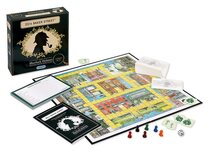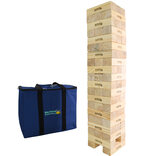The Rules of Go or Wei Chi
These friendly rules are designed to get you playing the game of Go quickly and fully without getting bogged down in the detail. We include the basic rules of Go, how to score and all the vital extra insights you need in a concise, no-nonsense form.
See also: Go.
Equipment and Aim
Go pieces are black and white lens-shaped discs called stones. The Go board can either be a flat table board or the more traditional floor-board with legs (Go-ban). Either way, the board is simply a grid of 19 x 19 lines, the stones being placed upon the intersections of the lines. For shorter games and for beginners, 13 x 13 and 9 x 9 boards are commonly used. Go is a game of territorial capture - the primary objective is to encircle as much territory as possible. In doing so, opposing stones may be captured and the winner is the player at the end with the greatest amount of territory and captured stones.
Basic Definitions
The most essential terms to understand are “group" and "liberty". A group of stones is any set of stones of the same colour that are connected orthogonally (horizontally or vertically). So three stones in a row along a line forms a group because every stone sits orthogonally next to at least one other stone. However 2 stones next to each other diagonally are not connected in any way and so simply form two groups of one stone each. If a third stone were to be added to the two diagonal stones so that it sat next to both of them, a group of three stones would be formed. Groups can get quite large and convoluted but the principle remains the same - if a stone lies orthogonally next to another stone then both stones are part of the same group. Any empty point orthogonally adjacent to a group of stones is said to be a liberty of that group. A single stone by itself in the middle of the board therefore has 4 liberties, 1 in each of the 4 directions. A group of 3 stones by itself in a line on the edge of the board has 5 liberties - 1 at either end and 3 towards the middle of the board. A single stone in the corner of the board has just 2 liberties. And a group of 8 stones set in a square by itself has 13 liberties - 12 around the outside and 1 in the middle. Each stone laid by the opponent next to a group reduces the number of liberties by 1. So a single stone with opposing stones North, South and East of it has only 1 liberty.
The Rules of Go
Go is not only pleasing to the eye, the game itself is also beautifully aesthetic in its simplicity. In essence there are really only 3 rules to the game:
- Starting with black, each player takes turns to place a single stone on the board.
- When a stone is played so that it causes a group of opposing stones to have no liberties, that group is captured.
- A player cannot play a stone to a location such that a previous position is repeated.
Eyes - the key to Go
An important point to realise is that a group of 8 stones set in a square is difficult to capture because if the opponent places a stone in the middle of the group, under most circumstances, that stone is immediately captured by the surrounding group. Consequently, no player would ever normally make such a play. The unoccupied point in the middle of the group is an example of an "eye". An eye is any empty point that is surrounded orthogonally by pieces of the same colour - always difficult for an opponent to capture. However, eyes are not impossible to take - the group of 8 stones can be captured by an opponent who first occupies the 12 surrounding points. After this, the group of 8 stones is vulnerable - if the player who owns it plays to the middle of the group, the group of 9 stones would be immediately captured having no remaining liberties. And this is the only situation where it is legitimate for the opponent to play a stone to the middle since in doing so, the last remaining liberty of the group is eliminated and the group is captured. The stone just played would be left surrounded by 4 liberties. Derived from this is the key factor in Go defence - any group containing two eyes is safe and can never be captured. This should be easy to understand after a moments thought - in order to capture the group all liberties must be eliminated and so both eyes would need to be occupied. But since a stone played to either eye would immediately be captured, it is impossible for both eyes to be occupied. QED. In conclusion, eyes are useful and a group with 2 eyes is invulnerable.
Other terms
"Ko" is a local situation in which a position can be repeated indefinitely. Normally, this is a simple situation where one player can take a stone and the other player can then play a stone back to where his stone has just been captured and take the first player's stone back again. Note that due to the third rule above, a player cannot immediately play a stone to put a position back to how it was. At least one stone must be played elsewhere before a player can reverse a Ko situation otherwise the a previous overall position of the board would be repeated. "Seki" is another local situation. This term applies to an area into which neither player dare play because to do so would cause the opponent to capture territory or stones. To have "Sente" is to be in a position to make a move that will force the opponent to take a counter-action. If a player with sente makes the play in question and the opponent, instead of responding in the predicted way, makes a different play with an even greater threat, the opponent is said to have "assumed Sente". Any group of stones that is under threat of imminent capture i.e. having only one liberty left is said to be in "Atari". A "dame" point is an empty point between territories. When there is a dame point there is no benefit to either player. Dame points are left alone until the end of the game and then ignored in scoring.
Starting
Go employs a simple and effective handicapping scheme. The weaker player always plays black but also places an amount of stones onto the board before the start of the game according to the amount of the handicap. The board has nine highlighted intersections in a square shape marked on the board called "star" points. The requisite number of stones are placed the star points in the following way:
- 1 stone handicap - on a corner star point
- 2 stone handicap - on opposite corner star points
- 3 and 4 stone handicap - on 3 or 4 corner star points
- 5 stone handicap - 4 corner + 1 side star point
- 6 stone handicap - 4 corner + 2 opposing side star points
- 7 and 8 stone handicap - 4 corners + 3 or 4 side star points
- 9 stone handicap - all 9 star points.
Finishing
Eventually, the players agree that no more stones can be played since all territory is claimed and all local battles have been played to their conclusion. Play continues until both players agree to this. At this point the winner and the margin of victory is determined. This is done in summary by comparing the sum of number of points of territory plus the number of prisoners captured. The totals are unimportant - it is the difference between them that is measured and it is customary to work this out in by following the following process which makes the counting much easier:
- First, any Dame points are filled – players continue to take turns playing their stones into these neutral areas until they are all filled. These are usually considered to be the final moves of the game - the game is only finished once all Dame points are filled.
- Any dead stones (stones within the opponent’s territory) are treated as prisoners and therefore they are now removed from the board into the pile of stones captured by each player.
- To simplify counting, next each black prisoner is placed back on the board in black territory and white prisoners are placed within white territory. The logic is simple – each prisoner counts 1 point so by placing on the board this point is lost but that is compensated for by the fact that the opponent loses a point of territory. Overall the difference remains the same.
- To further facilitate the counting process, stones on the board are now moved around so that the territories form neater patterns. In doing this, players simply take care not to change the amounts of territory owned. So each black stone moved exposes a point of territory but another black territory point is covered to compensate. Where possible, territories are manipulated into rectangular shapes and often larger territories are reformed into areas that are multiples of ten.
- Once the board and prisoners have been consolidated in this fashion, the winner and the margin of victory can be quickly determined by a count of the simplified territories.
These rules are provided by Masters Traditional Games, an Internet shop selling quality traditional games, pub games and unusual games. For general information or for copying and copyright, see our Rules Information page.
Our rules are comprehensive instructions for friendly play. If in doubt, always abide by locally-played or house rules.
Copyright James Masters, 2024. All rights reserved.








































